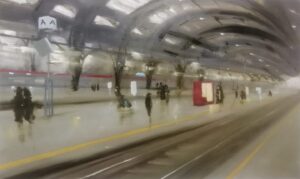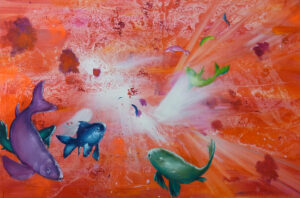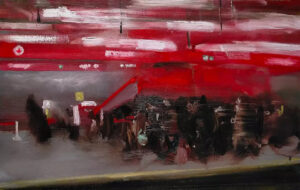Observing the works of the Milanese artist Gian Marco Capraro, winner of the Nourish Thought Awards, Brera Academy, Summer Award, Villa Moretti, Casaleggio Novara, Salon I, Museo della Permanente, Milan, we notice an evident versatility and desire to show the various facets of painting and above all of color, without getting lost in his visions, chasing new ghosts that make one lose focus on what one is working on. The artist, with a degree in philosophy and painting at the Brera Academy, sets the technique as a medium and this leads him to the final work without letting himself be carried away by preconceptions or ideologies. It is no coincidence that one of the points of reference of the Milanese artist is the writer Pier Vittorio Tondelli, who just did not want to know about ideologies, opting as Capraro does for minimalism and anti-naturalism. Like the Polish Kantor, Capraro condenses different styles of art history, focusing above all on the concept of death, on the degradation of objects and human beings.
The ephemeral material is used by Capraro precisely to give evanescence and a sense of anguish and transience to the messengers of death, to put it to Kantor, who are men but also things or animals as it can be seen from the pictorial cycle entitled “Attese” and “Almost Landscapes“, where our world, our ecosystem and our society are filtered by a clouded gaze: it is the eye of the flaneur, who wanders around the city without a precise destination but who scours hidden streets and lanes, trying to codify the city as a stratification of time and memory of those who lived there and still live there now, halfway between Baudelaire who was looking for correspondences in the symbols of Nature, and Kierkegaard. But if the latter is considered the philosopher of anguish, Capraro spares no irony and sarcasm, proposing colorful pop but also alienating tales and at the same time fascinating images of places that belong to everyone, because they become non-places like Piazza Corduso in Milan, an “impressionist” painting that also portrays the vision of the people who wander around that square, pervaded by a sense of loneliness and melancholy, perhaps in the absence of aspirations for the absolute.
Annalina Grasso: Your production is very varied. What makes the birth of a watershed possible in your case and why?
Gian Marco Capraro: Looking back at my artistic production, I realize that it is divided into long monothematic series. In fact, when I find a theme, be it seventeenth-century painting, semi-abstract compositions or landscapes, I focus almost exclusively on that one, trying to find even the slightest variations to the subject in question. I bond to such an extent that I find it impossible to dwell on anything else. This phase can usually last a few months, even a year or two. Then, suddenly, this inspiration, as it arrived, goes away. From one day to the next, a new need arises in me: maybe I no longer feel an affinity with acrylic or large sizes and I switch to oil and small formats, as it has recently happened. I think it is precisely the awareness of the exhaustion of the creative drive that leads me to focus so obsessively on only one subject at a time. In this process, technique plays a fundamental role: I believe that in painting it is the technique, that is how the medium is used, that leads you to one subject rather than another. There is not pre-established choice on what to paint: the oil lends itself well to the reflections and transparencies of the colored balloons in the same painting in which the flat and fluorescent shapes can only be painted with acrylic dyed brushes.
Who looks at the landscapes and views you paint? A hallucinatory eye or an eye that crosses things and cities?
In reality neither one nor the other, or perhaps both. The views I am painting now arise from the need to map Milan, the city where I live, trying to recreate an existential and human path. I started from the places where I live, also looking for the negative aspects: non-places, the Amazon warehouses, the deserted open space of the Ortomercato. Then fortunately my gaze widened to other areas of the city that retain a past, a memory that I have. What fascinates me and what I try to report is precisely the ability of the urban fabric to preserve a memory. Each of us could recreate an existential map of the city based on our own experience, and each would be different from the other. That bench in the park, the route traveled by bike on the morning of your degree thesis, the mezzanine of the metro in Bonola. This series of Milan landscapes is the continuation of the project I took to Copenhagen years ago and which had already been the subject of my degree thesis on Soeren Kierkegaard.
Do you think that the contemporary cities are all a little alike?
There are trends that lead to a certain urban homologation, so to speak. Gentrification is an ever-expanding phenomenon and large chains are present everywhere. Let’s look at the example of Berlin: of course it is a city with a particular history but I remember well when Mitte or Prenzlauerberg neighborhoods for me (who had not seen anything until then) were simply incredible: a mix of Prussian steel and houses with Art Nouveau facades and the smell of DDR-style lineolum in the hallways and along stairs. The second time I went there the Arkaden had already arrived, the first department stores to land from the West. Today they are super chic and approved neighborhoods. Something similar is happening in Milan: just think of the Isola district. I also believe that the real challenge will be played on ecology: only cities that are able to open up to the question will be able to renew themselves while remaining truly inhabited. Milan is doing it and I hope it continues on this path.
What do you like most about Copenhagen and what do you appreciate about its way of administering culture and art in particular?
As I said, years ago I was invited through Galeri Christopher Egelund to a three-month residency at Fabbrikken fur Kunst og Design. A factory converted into spaces for artists. My idea was to create a sentimental guide to that city, unknown to me at the time, through the work of some artists who had a studio in the Fabbrikken: they had to tell me about the most important places in Copenhagen for them. In practice, I found myself curating a group exhibition in which I too participated with a landscape of Christiania. That was the beginning of my landscape production. Going back to his question, at CPH they have a fixed day for the vernissages and on that day everyone, from the student, to the gallery owner, to the collector, goes around small bars displaying works by guest artists or super glossy galleries, without snubbing any place. In Italy it would be impossible. The community there is very small and everybody really knows each other, I didn’t feel the performance anxiety we have. Not to mention that, at least at the time, the state easily subsidized artistic initiatives (myself, as invited by a Scandinavian institution, had a salary, a studio, a two-story house and even a bicycle!).
You seem to live on artistic flares, where a different theme is present. Which one are you most fond of?
Favorite theme is always the one I’m working on right now. The human / urban landscape is certainly at the center of my interest now but I don’t put the other subjects in the background. Of course, among the works of the past, the Ancient Masters series is perhaps the one I am most attached to. My grandfather, my father and my brother were and are restorers, so contact with the antique has always been a constant since I was a child, this is combined with my interest in the representation of the body.
Would you define your painting as “intolerant”?
Not exactly, but I get impatient when I can’t paint the way I want! Joking aside, I notice that many painters are impatient in seeing their work considered by some critics in the background compared to an alleged “more intellectual” art where the idea prevails over the execution, as if painting could be perhaps now a language of the past. I believe instead that we must shake off this modesty: painting is absolutely a revolutionary act, never like now.
Who do you feel most influenced by?
By Raymond Carver and Pier Vittorio Tondelli, partly by Thomas Bernhard and perhaps in the past by the work of Tadeusz Kantor. Of the first two in particular I love the narration of everyday reality, both when it is tinged with the existential and dramatic implication like in Carver (The place where I am calling from) and when it leads to a romantic sublimation, as in Tondelli’s Autobahn, one of my favorite short stories. Especially in the Emilian writer I have always appreciated the urban scenography in which his characters have descended, a set with evaporated and strident colors very early in the 80s. At least in my opinion. If, on the other hand, I have to think about the world of art, I don’t really have an artist to refer to other than Edouard Manet, of whom I love his being a full metropolitan citizen, his investigating night bars and chantant cafes. He is truly the chronicler of the city, and he is very modern not only because he inspired the Impressionists but because he made the city the subject of his study, a concept that was absolutely avant-garde at the time.
Visual and intellectual aspect in your art go hand in hand. How was this approach born?
I let myself be inspired by what I like, of course. However, I perceive that this series on Milan is based on a very precise point of view which is still that of the university period and which then brought me to Denmark: it is the eye of the flaneur, who wanders around the city without a precise destination but probing streets, lanes and hidden streets, and that as an archaeologist tries to read the city as a stratification of time and memory of those who lived there and still live there.
Is art a lie that allows us to recognize the truth? How did Picasso say?
I answer you with another quote: Anything goes, everything is broth. It is the title of the autobiography of the philosopher Paul K. Feyerabend, an illuminating book. The intellectual process that leads us to find the truth, whatever it is and in any field, is not based on certain and immutable principles: scientific practice as well as artistic one can subvert any pre-established certainty. To this end, everything can come in handy. Even the lie.
Upcoming commitments?
Pandemic permitting, before the summer there will be a group exhibition at the Olimpia Rospigliosi space in Palazzo Borromeo with the artists who participated in “Quadri da sidewalk”, an exhibition cycle that has been held in recent months in Milan in five streets. The exhibition will be curated by Bohdan Stupak and collects the works of an excellent generation of artists who work with painting. Another opportunity that demonstrates how painting remains a decisive tool for reading contemporaneity. NFTs can wait.
Info:
 Gian Marco Capraro, photo courtesy the artist
Gian Marco Capraro, photo courtesy the artist
 Gian Marco Capraro, Stazione centrale, 100 x 60 cm, oil on canvas, 2021, photo courtesy the artist
Gian Marco Capraro, Stazione centrale, 100 x 60 cm, oil on canvas, 2021, photo courtesy the artist
 Gian Marco Capraro, Cordusio, 64 x 34 cm, oil on canvas, 2021, private collection
Gian Marco Capraro, Cordusio, 64 x 34 cm, oil on canvas, 2021, private collection
 Gian Marco Capraro, Leibneiz’s, 150 x 100 cm, oil and acrylic on canvas, 2015, photo courtesy the artist
Gian Marco Capraro, Leibneiz’s, 150 x 100 cm, oil and acrylic on canvas, 2015, photo courtesy the artist
 Gian Marco Capraro, La possibilità di un’altra isola, 150 x 100 cm, oil and acrylic on canvas, photo courtesy the artist
Gian Marco Capraro, La possibilità di un’altra isola, 150 x 100 cm, oil and acrylic on canvas, photo courtesy the artist
 Gian Marco Capraro, Attesa, 70 x 50 cm, oil on canvas, 2018, photo courtesy the artist
Gian Marco Capraro, Attesa, 70 x 50 cm, oil on canvas, 2018, photo courtesy the artist
 Gian Marco Capraro, Bonola, 45 x 35cm, oil on canvas, 202, photo courtesy the artist
Gian Marco Capraro, Bonola, 45 x 35cm, oil on canvas, 202, photo courtesy the artist
 Gian Marco Capraro, The place where I’m calling from, 3, 48 x 86, oil on canvas, 2015, photo courtesy the artist
Gian Marco Capraro, The place where I’m calling from, 3, 48 x 86, oil on canvas, 2015, photo courtesy the artist
 Gian Marco Capraro, Abyss, 2015, 12A, 25 x 60 cm, oilon canvas, courtesy Decorazon Gallery (Dallas/Londra)
Gian Marco Capraro, Abyss, 2015, 12A, 25 x 60 cm, oilon canvas, courtesy Decorazon Gallery (Dallas/Londra)
Journalist, blogger and social media editor from Campania. i graduated in literature and philology and I gained a master in art and organization of cultural events. I love cinema, art, music, literature, especially Russian, French and Italian. I read a lot, both narrative and non-fiction. I share Picasso’s thoughts on art: “Art helps us to recognize the truth”.






NO COMMENT